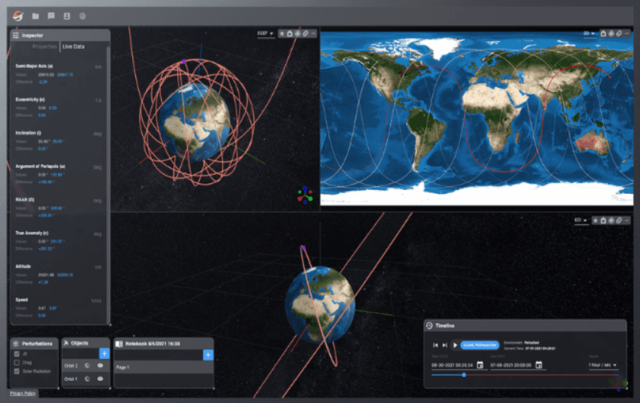
Space Force buys a digital twin of orbital space Slingshot Aerospace's Digital Space Twin. (Slingshot Aerospace/Released)
Space is a fast-moving and constantly changing domain where threats can arrive before troops even see them, so the Space Force is buying new technology to give troops a real-time picture of space to train in.
The service on Thursday awarded Slingshot Aerospace a $25-million, 39-month contract to provide a digital twin of orbital space. The system will autonomously comb through public and commercial data to provide Guardians a picture of the state of space as it is at any minute, including the locations of more than 7,000 orbiting satellites plus space debris, the potential for solar flares or other space weather, and the chance of disruptions to radio communications.
“Those risks change on a minute-by-minute timeline,” said Melanie Stricklan, the CEO of Slingshot Aerospace and an Air Force veteran.
Service officials hope the more accurate rendition of their operating environment will improve both wargames and real-world planning, according to a press release.
“If they needed to maneuver a communications satellite or constellation, they would be able to leverage this digital space twin through the quantitative analysis capability that it brings, including actual space weather and understanding of the radio frequency environment, to position in the right place at the right time,” Stricklan said.
The digital space twin at first will focus on providing a real-time picture of low-Earth orbit, but there are plans to expand it to geosynchronous orbit, where many military and commercial communications satellites are located, and even out to cislunar orbit as traffic around the moon becomes more congested, Stricklan said. She also described multiple commercial applications for the technology, including help risk modeling for space insurance, and providing more data for space serving companies operating on satellites in orbit.
The contract also includes a pilot program for the Space Force that will use simulations to help with training and education, the press release said.
Space wargames can help service members think through how they would react to an attack in orbit as well as how to mitigate the disruption if such an attack hurt ground, sea, or air operations—say, if GPS or communications satellites were taken offline. One of the most prominent is the Schriever War Game, an annual exercise that began in 2001. The 2020 exercise, the first one hosted by the Space Force, included more than 200 participants from eight countries.
Wargames that concern satellites—whether directly or in their effects on ground and air operations— are especially important because space is a newer domain from the military, said Bruce McClintock, head of the RAND Corporation’s Space Enterprise Initiative. While sailors or airmen can pull from centuries and decades of previous conflicts for lessons learned, space doesn’t have a long history of examples to consider.
“The silver lining for strategy is if you fought a conflict before, you can learn something from those experiences,” McClintock said. “That’s not true in space yet.”
Space exercises also help educate more troops about how important space is to almost everything the military does, something many people still don’t understand because space is not as visible as flying or operating on the ground, he said.
Planning wargames in space poses a unique challenge because the in-orbit environment can be very hard to picture, in part because satellites in low-Earth orbit can whiz by as fast as 16,000 miles per hour, according to Tim Coffin, managing director of the space warfighting division at MITRE.
“It’s hard for people to understand and visualize that a threat to them in space could be something on the other side of the Earth,” he said.
___
© 2022 Government Executive Media Group LLC Distributed by Tribune Content Agency, LLC




